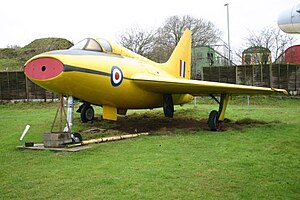Boulton Paul P.111
| P.111 | |
|---|---|
 |
|
| VT 935, the P.111A on display at the Midland Air Museum | |
| Role | research aircraft |
| Manufacturer | Boulton Paul |
| Designer | Dr S.C. Redshaw |
| First flight | 10 October 1950, |
| Retired | June 1958 |
| Primary user | Royal Aircraft Establishment |
| Number built | 1 |
| Variants | Boulton Paul P.120 |
The Boulton Paul P.111 (also called Boulton Paul BP.111) was a British experimental aircraft of the 1950s designed to explore the characteristics of tailless deltas.
In the late 1940s and early 1950s the Allied aircraft industries were engaged in many projects to confirm and develop the design ideas captured from Nazi Germany at the end of the Second World War. As part of this activity the P.111 was built for the Air Ministry to specification E.27/46 by Boulton Paul Aircraft Ltd to investigate the possibilities of the delta planform wing.
The P.111 was designed as the smallest airframe which could couple an engine (Rolls-Royce Nene), an ejection seat (Martin-Baker), and a delta wing. The latter was aerodynamically thin and had a sweep angle of 45°. Without tip extensions the wing was strongly cropped at about 75% of the full delta. The aircraft could be flown with these wings or with one of two pairs of extensions, the larger ones making an almost perfect pointed delta shape. These extensions allowed an investigation of the aerodynamic effects of the tip shapes of delta wings. Unlike its contemporary the Avro 707, roll and attitude were both controlled by a pair of elevons. The fin had an unswept trailing edge and its tip also could be removed and altered, though it seems it always flew with a very pointed tip. The P.111 was fitted with one of the first fully powered control systems, hydraulically driven with electrical trim tabs. Because the Nene had a centrifugal compressor, the P.111 had a rather tubby fuselage, with an oval nose intake. The inward-retracting undercarriage had a noticeably wide track and a tall nosewheel leg placed it at 17° on the ground. The construction was all-metal with the exception of the wing extensions and the fin tip, which were of glass-reinforced plastic.
...
Wikipedia
